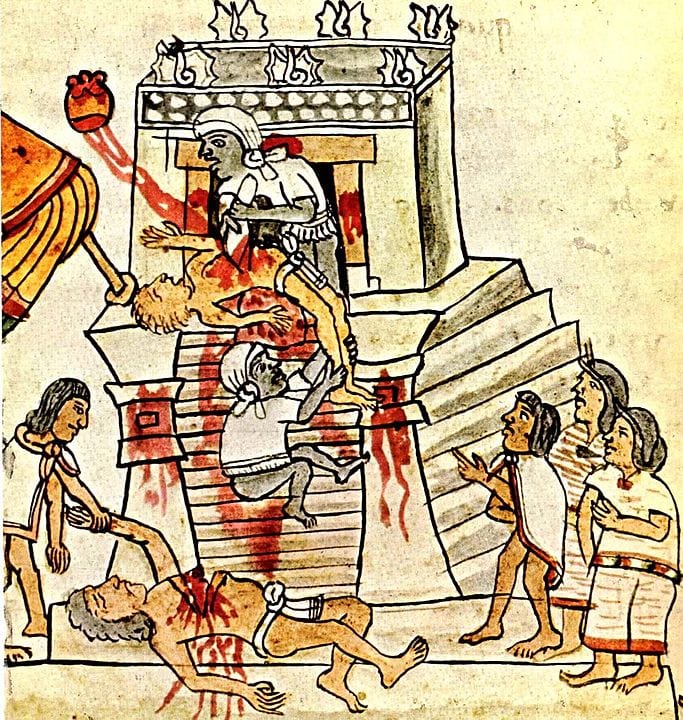Yesterday I blogged about the proposed “model curriculum” for public schools in California that has students chant prayers to Aztec gods. Among many other reasons why this is a bad idea, I said that this exemplifies the intellectual bankruptcy of a particular technique favored by progressive education.
The assumption that students can learn from “experiential learning activities” apart from also teaching objective knowledge just doesn’t work. Students learn nothing about the Aztecs or their religion–which are actually fascinating topics–from praying modern-day petitions to their idols. These particular Aztec deities were actually worshipped by offering human sacrifices.
I wondered how education shaped by critical theory would handle that fact, which is the subject of this post. I speculated that critical theorists would deny that the Aztecs practiced human sacrifice, and that they would blame the “narrative” to the contrary on their colonial oppressors, who were trying to discredit the native culture and to justify their destruction of that culture and their imposition of Christianity.
Sure enough, this is what I found. But the blatant scholarly dishonesty in making these claims, despite superabundant evidence to the contrary, was beyond anything that I expected.
Just reading the Wikipedia article Human Sacrifice in Aztec Culture and attending to its documentation shows that the practice is extraordinarily well-attested. Historians, anthropologists, archaeologists, and other specialists know a great deal about the custom of human sacrifice. This is based not only on the testimony of conquistadors and other colonial sources. There are native accounts, Aztec manuscripts, sculptures that depict the sacrifices, and actual drawings by Aztecs that show how the sacrifices were carried out. The famous Aztec stone calendar depicts the cycles of sacrifices required throughout the year. Archaeologists have uncovered hundreds of skeletal remains, with some of the bones showing the abrasions from obsidian knives that cut out the victim’s heart.
A Wikipedia editor, however, added the information that some scholars believe that the Aztecs did not, in fact, practice human sacrifice. No details were given, but a footnote was provided, linking to an article by Dr. Elizabeth Graham, Senior Lecturer in the Archaeology of Latin America at University College London, entitled “There is no such thing as ‘Human Sacrifice’.”
She does not deny that people were killed–how could she, with all of the drawings and skeletons? But she says that Aztec warriors did not want to kill in battle, as Western colonialists do. Rather, they wanted to just take captives. Yes, some of these captives were killed later. But most were not. Probably fewer people died in Aztec wars than die in our Western wars, so the native people are still morally superior.
But what about all of the religious connections documented by so many scholars? Well, she says, wars are always being justified by religions. The West does that too.
Surely, she argues, if we are going to have wars–not that she’s in favor of them–it’s better to wage them as the Aztecs did. “Even though they wound up killing very few of their enemies compared to all the people who actually fought in the war,” she writes, “we think of them as more bloodthirsty than we are.” But they weren’t. The Aztecs fought wars for the same reason we do–for “resources, wealth, power”–but “delayed killing” is actually more humane.
The stories to the contrary, all of those lurid descriptions of Aztec cruelty, were made up by Spanish “friars” seeking to justify their colonialism.
It is true that the mass sacrifices offered at the great pyramid were captives. In fact, the motive of Aztec wars–instead of being for resources, wealth, and power–is said to be the seizing of enough captives to offer the gods, something attested to by the indigenous people of other tribes who were so oppressed by the Aztecs that they often supported the Spanish in their war against them.
But other sacrifices were not of captives at all. “Virtually all child sacrifices were locals of noble lineage,” says the Wikipedia article, with three footnotes to scholarly sources, “offered by their own parents.” Sometimes devout Aztecs would offer themselves as sacrifices to the gods. Sometimes young men and women would be specially chosen for the honor of being sacrificed.
The article gives the sacrifices required according to the Aztec calendar. On some days a child is required. Sometimes a woman. Sometimes captives. Sometimes “a maid.” Sometimes the sacrifice is not by extraction of the heart but by drowning or burning or flaying or starving. Sometimes the rite includes cannibalism. Sometimes not.
Interestingly and significantly, the deity being prayed to in the model ethnic studies curriculum, Tezcatlipoca, received a special sacrifice. According to a much more scholarly online article,
To Tezcatlipoca was dedicated one of the most ostentatious and imposing ceremonies of the Aztec religious calendar year. This was the Toxcatl or One Drought sacrifice, which was celebrated at the height of the dry season in May and involved the sacrifice of a boy. A young man was chosen at the festival among the most physically perfect prisoners. For the next year, the young man personified Tezcatlipoca, traveling through the Aztec capital city of Tenochtitlan attended by servants, fed with delicious food, wearing the finest clothing, and being trained in music and religion. About 20 days before the final ceremony he was married to four virgins who entertained him with songs and dances; together they wandered Tenochtitlan’s streets.
The final sacrifice took place at Toxcatl’s May celebrations. The young man and his entourage traveled to the Templo Mayor in Tenochtitlan, and as he walked up the stairs of the temple he played music with four flutes that represented the world’s directions; he would destroy the four flutes on his way up the stairs. When he reached the top, a group of priests carried out his sacrifice. As soon as this happened, a new boy was chosen for the following year.
The best-looking youth–a teenager–is chosen. For a year, he lives a life of luxury and indulgence, culminating in a sexual fantasy. He is treated like the god himself. And then he is sacrificed.
Read the article denying that the Aztecs committed human sacrifice, and then read the Wikipedia article that surveys the research. Then read the article about Tezcatlipoca. Doesn’t the denial article seem rather thin in its evidence (to put it kindly)? Doesn’t the author make an exceedingly weak case? And yet, I suspect that her view carries more weight in the contemporary academic world. Not just primary education but higher education are corrupted by the current regnant ideology.
One more point: The charge will be made that you Christians too believe in human sacrifice! All this about Jesus dying on the cross for your sins! Well, Jesus was human and He is also God. The whole point of Christianity is that we don’t have to sacrifice ourselves or other people to God. Rather, He sacrifices Himself for us.
That Aztecs and other people of the world throughout history practiced human sacrifice is a testimony to our brokenness and our fallen nature. There is an instinct that says we must pay for our sin, and we must placate the divine. Some people throughout history and many cultures have been so desperate that out of their misplaced piety they sacrifice what is most precious to them, their own children.
But the Bible forbids that. All religions are not the same. Abraham was willing to sacrifice his own son, as his Canaanite neighbors would have, but God not only stopped him, He provided a substitute: A thorn-encircled lamb.
And so He does for us.
Illustration: Human Sacrifice, by Unknown author – Extract of Codex Magliabechiano [a collection of Aztec manuscripts] (cf. FAMSI (Foundation for the Advancement of Mesoamerican Studies, Inc.), Public Domain, https://commons.wikimedia.org/w/index.php?curid=7828418














